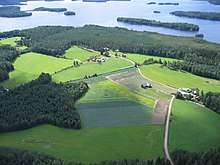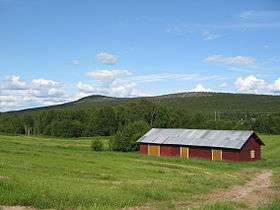Agriculture in Finland

Agriculture in Finland is characterized by the northern climate and self-sufficiency in most major agricultural products. Its economic role is declining in terms of GNP and employment in primary production, but together with the food industry and forestry with which it is linked, it forms a significant part of the Finnish economy.[1][2] The number of farms has steadily declined for the last decades. Between 2000 and 2012 their number fell from almost 80,000 in 2000 to about 60,000, while the amount of arable land has slightly increased to a total of almost 2.3 million hectares.[2] Agriculture employed 125,000 people in 2010, which is a drop of 30 percent from 2000.[3]
A study to examine job resources, work engagement and Finnish dairy farmers' preferences concerning methods to enhance overall well-being while working on farms was conducted. The results indicate that the family, working with cattle, healthy farm animals, a reasonable workload, and a sustainable farm economy have the capacity to create positive impacts on well-being among dairy farmers. Well-being on farms is a part of sustainable food production.
Geography
The majority of farms and agricultural land in Finland lie between the 60th and 65th parallel,[4] making it the only country in the world with a significant agricultural sector so far in the north.[5][6] The percentage of farms concentrating on animal production increases towards the north and east.[7]
Notes
- ↑ "Agriculture". Ministry of Agriculture and Forestry. 2010. Archived from the original on July 30, 2012. Retrieved January 2, 2013.
- 1 2 Statistics Finland 2012.
- ↑ Tike 2011.
- ↑ Tike 2010. p. 29
- ↑ The claim can be verified by a comparison of national agricultural statistics from Canada, Norway, Russia, Sweden and the United States. (Statistics Norway 2001, Statistics Canada 2007, Jordbruksverket 2008, USDA 2009 (p. 276), Federal State Statistics Service 2011 (pp. 219-221, 236-243))
- ↑ The difference is most pronounced for crop production and there are for example dairy farms in Norway north of the Finnish border in the Teno river valley near the 70th parallel. (photograph)
- ↑ Tike 2010. p. 55
References
- Federal State Statistics Service (2011). Сельское хозяйство, охота и охотничье хозяйство, лесоводство в России [Agriculture, hunting and forestry in Russia] (in Russian). Archived from the original on 2012-07-05. Retrieved January 3, 2013.
- Jordbruksverket (2008). "Jordbruksmarkens användning" [Agricultural land use] (in Swedish). Jordbruksverket. Archived from the original on March 11, 2010. Retrieved January 3, 2013.
- Statistics Canada (2007). "Farms in the territories". 2006 Census of Agriculture. Statistics Canada. Retrieved January 3, 2013.
- Statistics Finland (2012). "Agriculture, Forestry and Fishery". Finland in Figures. Statistics Finland. Retrieved January 2, 2013.
- Statistics Norway (2001). "Census of Agriculture 1999". Retrieved January 3, 2013.
- Tike (2010). Farm Register 2009 (PDF). Tike, Information Centre of the Ministry of Agriculture and Forestry. Retrieved January 3, 2013.
- Tike (2011). "Agricultural Census 2010 - Labour force, preliminary data". Farm Structure Survey. Tike, Information Centre of the Ministry of Agriculture and Forestry. Retrieved January 2, 2013.
- USDA (2009). 2007 Census of Agriculture. Volume 1, U.S. Summary and State Report (PDF). United States Department of Agriculture. Retrieved January 3, 2013.
